Butterflies undergo complete metamorphosis. Which figure represents the life cycle of butterflies?

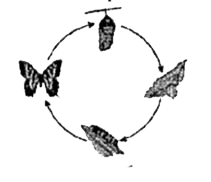
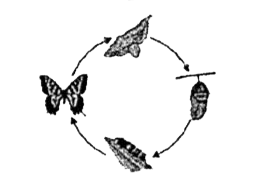

The correct Answer is:A
To determine which figure represents the life cycle of butterflies, we need to understand the complete metamorphosis process that butterflies undergo. Here’s a step-by-step breakdown of the life cycle:
Step 1: Understanding Complete Metamorphosis
Complete metamorphosis involves four distinct stages: egg, larva (caterpillar), pupa (chrysalis), and adult (butterfly).
Step 2: Identifying the Stages
1. Egg: The life cycle begins when the female butterfly lays eggs on a suitable plant.
2. Larva (Caterpillar): After a few days, the eggs hatch into larvae, commonly known as caterpillars. This stage is primarily for feeding and growth.
3. Pupa (Chrysalis): Once the caterpillar has grown sufficiently, it enters the pupa stage, where it undergoes transformation within a protective casing.
4. Adult (Butterfly): Finally, the adult butterfly emerges from the pupa, completing the life cycle.
Step 3: Analyzing the Options
Now, we need to look at the figures provided in the question and identify which one correctly represents these stages:
- Option 1: Egg → Larva → Pupa → Adult (Butterfly)
- Option 2: Egg → Larva → Adult (Butterfly)
- Option 3: Egg → Pupa → Adult (Butterfly)
- Option 4: Egg → Adult (Butterfly)
Step 4: Selecting the Correct Option
From the analysis:
- Option 1 correctly shows all four stages of complete metamorphosis: Egg → Larva → Pupa → Adult (Butterfly).
- The other options do not include all the necessary stages.
Conclusion
The correct answer is Option 1, as it accurately represents the complete life cycle of butterflies.
---
Complete metamorphosis involves four distinct stages: egg, larva (caterpillar), pupa (chrysalis), and adult (butterfly).
1. Egg: The life cycle begins when the female butterfly lays eggs on a suitable plant.
2. Larva (Caterpillar): After a few days, the eggs hatch into larvae, commonly known as caterpillars. This stage is primarily for feeding and growth.
3. Pupa (Chrysalis): Once the caterpillar has grown sufficiently, it enters the pupa stage, where it undergoes transformation within a protective casing.
4. Adult (Butterfly): Finally, the adult butterfly emerges from the pupa, completing the life cycle.
Now, we need to look at the figures provided in the question and identify which one correctly represents these stages:
- Option 1: Egg → Larva → Pupa → Adult (Butterfly)
- Option 2: Egg → Larva → Adult (Butterfly)
- Option 3: Egg → Pupa → Adult (Butterfly)
- Option 4: Egg → Adult (Butterfly)
From the analysis:
- Option 1 correctly shows all four stages of complete metamorphosis: Egg → Larva → Pupa → Adult (Butterfly).
- The other options do not include all the necessary stages.
The correct answer is Option 1, as it accurately represents the complete life cycle of butterflies.
Topper's Solved these Questions
Similar Questions
Knowledge Check
Frogs undergo complete metamorphosis. Which figure represents the life cycle of frogs?
A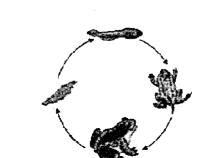 B
B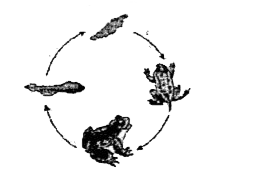 C
C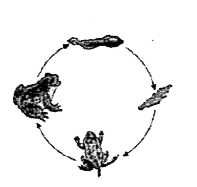 D
D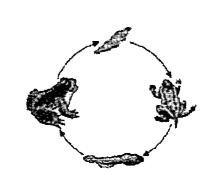
An insect which undergoes complete metamorphosis is called
AAmetabolaBHemimetabolaCHolometabolaDNone of theseWhich of the following represents resting stage in the life cycle of butterfly?
ACaterpillarBLarvaCPupaDTadpole
What does the caterpillar transform into during the life cycle of a butterfly?
View SolutionOne of the following animal has no metamorphosis in its life cycle
View SolutionPlasmodium completes its life cycle in
View SolutionDrosophila melanogaster complete their life cycle in about
View SolutionA passage is given with five questions following it. Read the passage carefully and select the best answer to each question out of the given four alternatives.
There is exciting news for butterfly enthusiasts. By studying 207 species of butterflies, scientists have created an evolutionary tree painting the detailed picture of butterfly relationships and evolution over time.
An international team of lepidopterists carried out DNA studies and carbon dating analysis to understand the age and characteristics of butterflies. By comparing and merging previous studies on butterflies ,the researchers were able to create the new bigger and better evolutionary tree.
"We still have a long way to go, but this is the first comprehensive map of butterfly evolution," said Akito Y. Kawahara, associate professor at the Florida Museum of Natural History in a release. "Lots of previous studies cover butterfly evolution on smaller scales — by locality or taxon — but surprisingly few have reached across the breadth of butterfly diversity." Dr. Kawahara is the corresponding author of the paper published in Current Biology.
The report also supported previous studies that butterflies originated around 119 million years ago in the late Cretaceous period. After the mass extinction (65 million years ago), most of the butterflies diverged into many different groups. The butterfly species were placed in seven groups — Papilionidae, Hedylidae, Hesperiidae, Pieridae, Riodinidae, Lycaenidae and Nymphalidae.
"Our analyses support swallowtails (Papilionidae) as sister to all other butterflies, followed by skippers (Hesperiidae) and the nocturnal butterflies (Hedylidae) as sister to the remainder," says the report.
The whites (Pieridae) were supported as sister to brush-footed butterflies (Nymphalidae), blues and metalmarks (Lycaenidae and Riodinidae). Previously, swallowtails and birdwings were believed to have a common ancestor but the new study showed that they feed on different plants. "That tells us that butterflies and plants may have evolved together," Dr.Kawahara added. They also studied the association of butterflies with ants. Some butterfly larvae secrete sugars that serve as a meal for ants and the ant in return protects the larva from other predators. This is a well-studied symbiotic relationship. The scientists report that most of the blue butterflies and hairstreaks and some of the metalmark butterflies exhibit this behaviour. "We [India] have about one fifth of the known moths and butterflies represented in Indian collections (3,800 out of an estimated 20,000 species). The only way they could undertake the study was the fact that they have access to a good collection. We lack this in India," explained Smetacek.
Which group of butterflies is known as nocturnal butterflies?
View Solution
